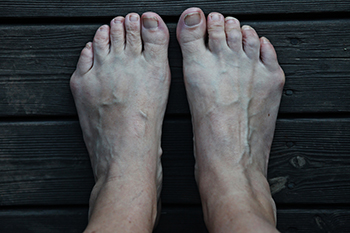
A tailor’s bunion, also known as a bunionette, is a bony bump that forms on the outside of the foot near the base of the little toe. It occurs when the fifth metatarsal bone shifts outward, often due to genetics, improper foot structure, or wearing narrow, tight shoes that squeeze the toes together. Symptoms include a visible bump, redness, swelling, and pain along the outside of the foot. It may feel irritated or sore, especially when walking or wearing tight shoes. Over time, the discomfort can worsen and make regular activities more difficult. A podiatrist can diagnose a tailor’s bunion through a physical exam and X-rays, then recommend a personalized treatment plan. Non-surgical options include padding, footwear modifications, custom orthotics, and anti-inflammatory medications. In severe cases, surgery may be considered to realign the bone and relieve pain. If you are experiencing this condition, it is suggested that you schedule an appointment with a podiatrist for appropriate treatment.
If you are suffering from bunion pain, contact one of our podiatrists of Advantage Foot and Ankle Center . Our doctors can provide the care you need to keep you pain-free and on your feet.
What Is a Bunion?
Bunions are painful bony bumps that usually develop on the inside of the foot at the joint of the big toe. As the deformity increases over time, it may become painful to walk and wear shoes. Women are more likely to exacerbate existing bunions since they often wear tight, narrow shoes that shift their toes together. Bunion pain can be relieved by wearing wider shoes with enough room for the toes.
Causes
- Genetics – some people inherit feet that are more prone to bunion development
- Inflammatory Conditions - rheumatoid arthritis and polio may cause bunion development
Symptoms
- Redness and inflammation
- Pain and tenderness
- Callus or corns on the bump
- Restricted motion in the big toe
In order to diagnose your bunion, your podiatrist may ask about your medical history, symptoms, and general health. Your doctor might also order an x-ray to take a closer look at your feet. Nonsurgical treatment options include orthotics, padding, icing, changes in footwear, and medication. If nonsurgical treatments don’t alleviate your bunion pain, surgery may be necessary.
If you have any questions, please feel free to contact our office located in Newark, DE . We offer the newest diagnostic and treatment technologies for all your foot care needs.
